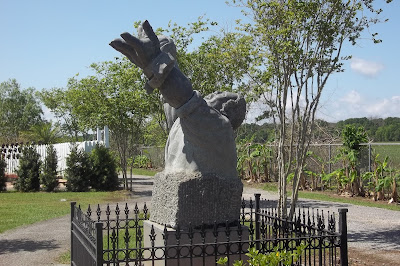The wealth of the sugar business, so clearly expressed in the beautiful 18th century mansions that lie at the heart of each plantation, was built on the bitter suffering of hundreds of thousands slaves who were transported from West Africa to the hot and humid fields of Louisiana.
Whitney plantation is unique among the plantations along the river road in that its focus is on the experience of the slaves themselves. It is both a museum about slavery (the only one in the US) and a memorial to the slaves who lived and died on Whitney Plantation.
The picture (above) shows our guide standing in front of the memorial wall, on which the names of all the Whitney slaves are inscribed - just their Christian names, because slaves did not have surnames - together with excerpts from the deeply affecting testimonies of elderly former slaves that were collected in the early 1930s.
Nearby, some former slave cabins (left), are a stark reminder of the primitive conditions in which the slaves lived, whilst their masters lived in the opulent splendour of the big house (see below).
In addition to the detailed documentary research that has gone into presenting the history of the Whitney Plantation (and the accompanying memorials), the owners have commissioned several pieces of art which add their own powerful message.
 Throughout the site there are regular reminders of the thousands of children who were born into slavery and who worked as slaves from their earliest years in these beautiful statues of slave children, made by a local artist. It is particularly affecting to see the children sitting in the church on the plantation.
Throughout the site there are regular reminders of the thousands of children who were born into slavery and who worked as slaves from their earliest years in these beautiful statues of slave children, made by a local artist. It is particularly affecting to see the children sitting in the church on the plantation.The Antioch Baptist Church was set up by freed slaves after the act of emancipation (when slavery was abolished in the US). They liked the Biblical name of Antioch because it sounded like 'Anti-Yoke' and they were profoundly anti-yoke.
'
The other very striking sculpture at Whitney is the 'Hallelujah Statue' which wonderfully expresses the joy of the slaves on the day they were set free.
I've a little more to tell you about our journey along the river road of Louisiana in a future post but the 'Hallelujah Statue' is a good note to end on for today.









No comments:
Post a Comment